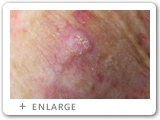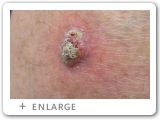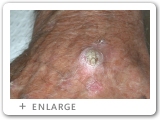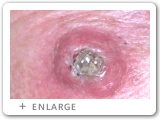
|
|
Skin Cancer Types
|
|
|
Facts & Stats
|
|
|
Related Conditions
|
|
|
What is Squamous Cell Carcinoma
Squamous cell carcinoma is the second most common type of cancer. Unlike basal cell carcinoma, squamous cell carcinoma has the potential to spread to internal organs, and can be fatal if left untreated.
Squamous cell carcinoma often starts as a small nodule, and slowly grows with time. As it grows, the center becomes necrotic. Bleeding and ulceration are common as the tumour advances, and is commonly seen in sun exposed areas. HPV infection is thought to increase the likelihood of developing squamous cell carcinoma. Actinic keratoses have the potential to turn into squamous cell carcinomas.




- Starts out as a small nodule
- Grows relatively slowly
- Bleeding and ulceration suggest advancement of tumour
- Actinic keratosis can turn into this invasive form of cancer
- Presentation can vary widely
Common identifying features:
- Can often resemble an ulcer
- Often elevated above the surface skin
- Changes from a pink color to a white color as it advances
- Most common on the face, forearms, back of the hands, and legs where exposed to the sun
- Scaly and crusty
- Reddish in color
- Appearance can vary widely
SCC Facts:
- The second most common skin cancer
- Unlikely to metastasize, but certainly possible
- More common in the elderly
- Men are significantly more likely to develop SCCs
Related:
Top
|